“I want to be… a YouTuber!” – the answer from a nine-year-old makes her mother pause for a moment. No longer dreaming of being a doctor, teacher, or astronaut, today’s young generation grows up with faces they see every day on their phone screens: KOLs – Key Opinion Leaders. They have become icons of success, living from their passion, admired by many and… earning substantial income. Yet behind that bright spotlight lies a serious question: how can influence go hand in hand with responsibility, ensuring that dreams materialise without turning into illusions?
Original Vietnamese version available here: Đọc bài viết tiếng Việt
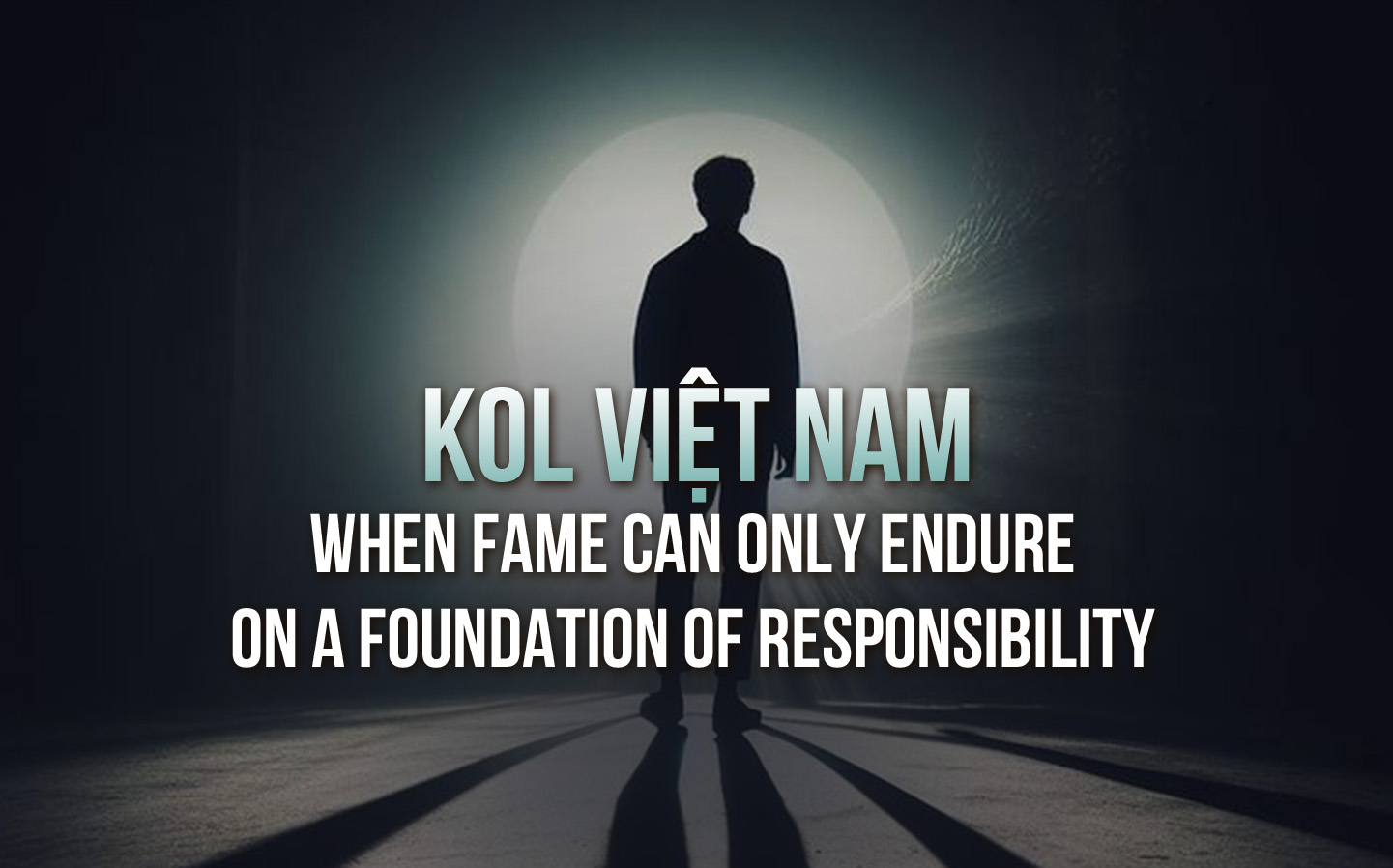
When influence becomes an “economic tool”
KOLs are no longer an unfamiliar concept. KOL, short for Key Opinion Leader, refers to individuals who have the ability to shape public perception, trends, and decisions within a specific field. They may be professionals (doctors, lawyers, engineers), celebrities (singers, actors, athletes) or social media content creators with large followings. What unites them is the trust they have earned from their communities through expertise, real-life experience, or personal credibility, enabling them to influence public opinion and directly drive consumer behaviour.
According to the Influencer Marketing Asia 2024 report, 86% of consumers in Asia say they trust recommendations from knowledgeable individuals more than direct advertising. Brands have adapted accordingly: instead of pouring budgets into traditional advertising, they are choosing KOLs as “ambassadors of trust” – people who can resonate emotionally and connect with customers in ways conventional media often cannot.
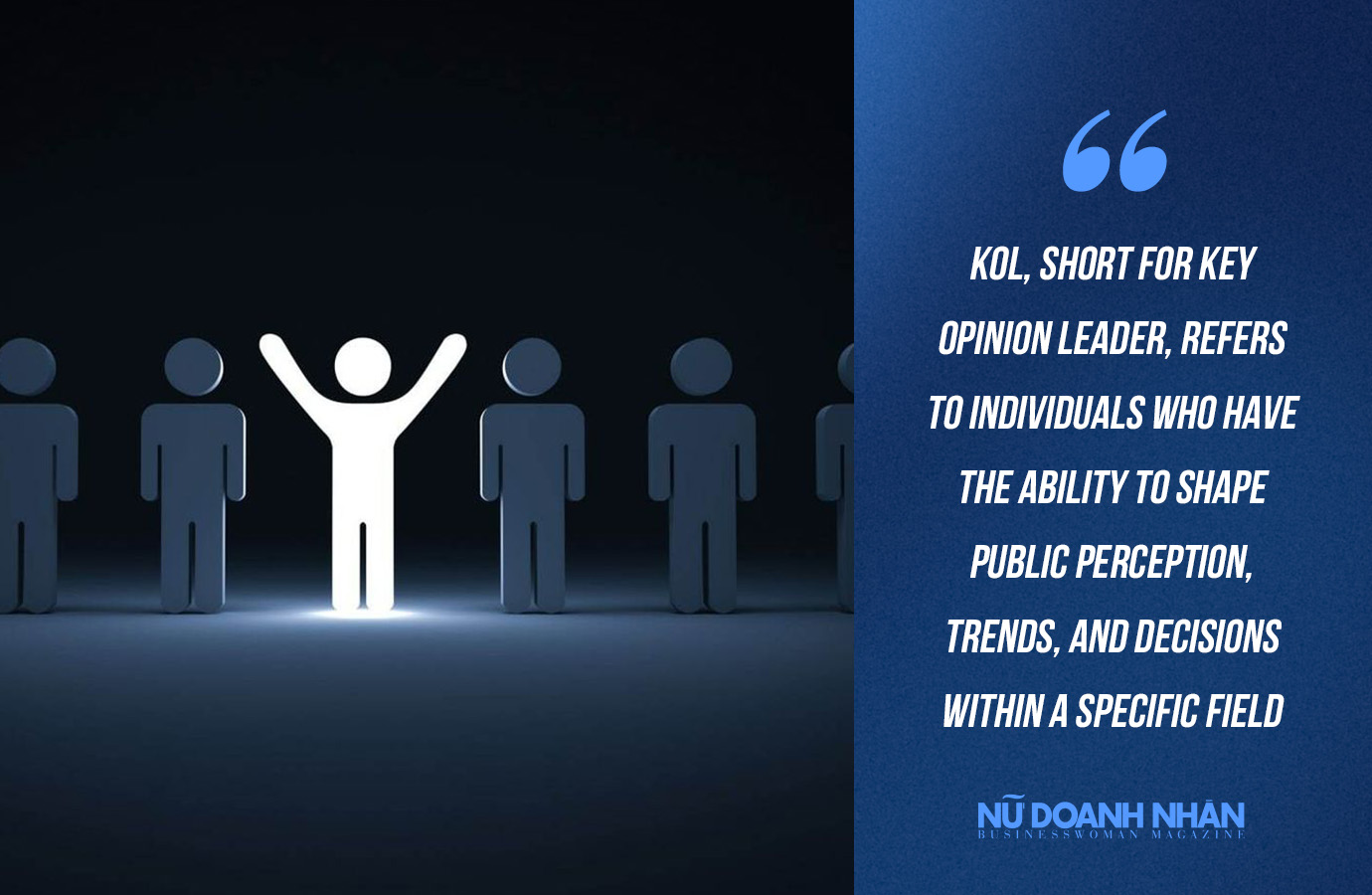
In South Korea, the influencer marketing sector was worth over USD 1.5 billion in 2024, with KOLs in beauty, e-sports, and music playing a crucial role in spreading the global “Hallyu wave”. Japan has seen a surge in virtual influencers – AI-generated personas – with the market projected to reach USD 900 million by 2025, positioning the country as a leader in tech-driven influencer marketing in Asia.
In the United States, the influencer marketing industry was valued at USD 21.1 billion in 2023, according to Influencer Marketing Hub. Figures such as MrBeast and Kim Kardashian can command USD 2–3 million for a single video or post. In Europe, particularly Germany and the UK, influencer marketing has grown significantly in fashion and tourism, with 67% of luxury brands citing it as a “strategic priority” (Statista 2024). In Brazil – South America’s largest market – the industry is expected to reach USD 2.7 billion by 2025, as KOLs become a vital tool for engaging a tech-savvy young audience.
China’s livestream commerce – largely driven by KOLs – generated over USD 130 billion in revenue during the 11.11 shopping festival alone in 2023, according to iiMedia Research. Individual streamers can earn millions in a single night. This boom has transformed the KOL sector into one of the defining economic engines of the 21st century.
Vietnam is no exception. The influence of KOLs has evolved into a fully-fledged economic sector. Names such as Lê Anh Nuôi – a standout in the culinary scene; Diệp Lê – highly sought after by beauty and fashion brands; Huy Cung – known for his creative entertainment content; Trinh Phạm – a prominent beauty YouTuber; Quỳnh Anh Shyn – a fashion figure embraced by global brands; Helly Tống – an icon of sustainable living; Châu Bùi – a fashionista whose influence extends beyond Vietnam’s borders; and Sơn Tùng M-TP – a music star capable of shaping market trends, all exemplify the industry’s potential. Some KOLs generate hundreds of millions, even billions of đồng monthly. For many major brands, KOL budgets are considered strategic investments: a single, well-timed post can send a product flying off the shelves within hours. KOL work is no longer a short-term gig; it has become an “economic profession” where creativity and credibility translate directly into profit.
Global response: from “wild west” to regulatory framework
No country allows an industry with such far-reaching influence to develop entirely unchecked.
In China, the government has issued a Code of Conduct for livestream hosts, banning 31 practices ranging from exaggerated product claims and sexually suggestive content to tax evasion. In 2024, the Cyberspace Administration of China sanctioned or suspended over 1,300 accounts, including several high-profile influencers.
South Korea was shaken by a series of “hidden advertising” scandals in beauty and entertainment. The government responded with mandatory labelling of all sponsored content and the disclosure of remuneration. One year after enforcement, a Korea Consumer Agency survey showed that the percentage of viewers who said they “trust sponsored content” had risen by 40%, proving that transparency does not diminish appeal – it strengthens it.
Japan has focused on copyright and digital ethics, particularly with the rise of virtual influencers. The Ministry of Internal Affairs and Communications of Japan requires that all AI-generated characters based on real people have explicit written consent and must be labelled “AI generated” to protect personal rights and prevent online fraud.
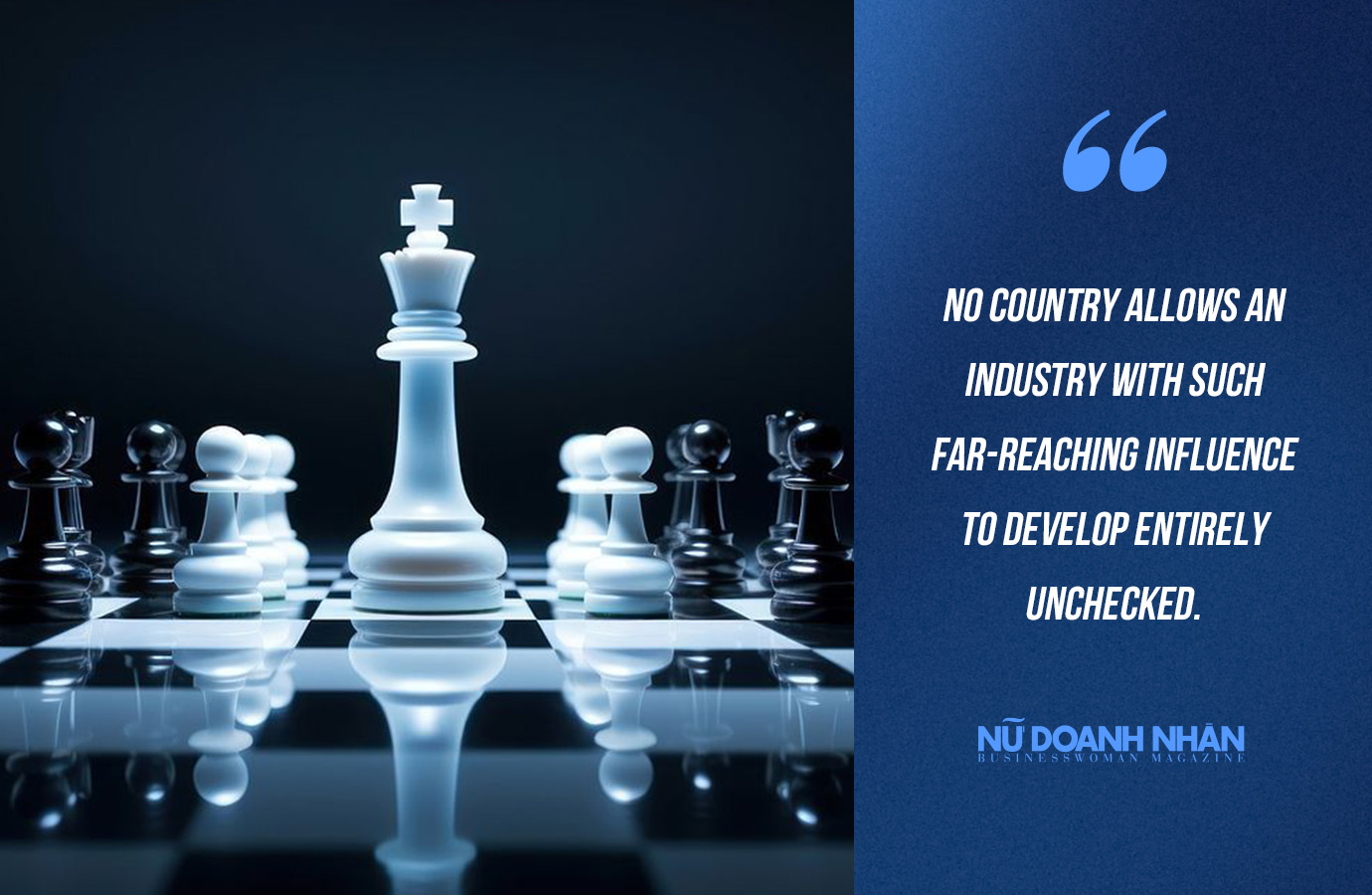
The European Union (EU) has enacted the Digital Services Act (DSA), compelling major platforms to monitor, remove misleading content, and disclose commercial relationships between KOLs and brands. Breaches can incur fines of up to 6% of global annual turnover, a figure powerful enough to deter even the largest tech firms.
The United States has long maintained a robust regulatory framework. The US Federal Trade Commission (FTC) requires all collaborations to be clearly labelled, prominently displayed, and easily understood. Violations can lead to hefty fines in the hundreds of thousands of dollars or outright bans. In 2023, the FTC expanded its rules to include AI-generated content, ensuring consumers are not misled by “technological illusions”.
Australia and Canada have pioneered industry codes of ethics, promoting self-regulation backed by penalties for breaches, alongside mandatory reporting on campaign transparency and performance when KOLs are involved.
These measures illustrate a global shift: from a “Wild West” where influencers operated with little accountability to an era of strict “rules of the game”, where public trust is the ultimate currency.
Vietnam: time to lay the foundations
Vietnam has clear advantages: a young population (60% under 35), social media penetration exceeding 75% of the population (Digital 2025 Report by We Are Social & Meltwater), and an e-commerce sector growing at an average of 25% annually. Yet fundamental issues persist: opaque collaborations, inflated metrics, and sensationalist content.
Positive signs of change have begun to emerge. On 18 August 2025, in Hà Nội, the first-ever National KOL Conference was held under the theme “KOL Summit 2025 and the Nation’s Era of Ascent”, organised by the National Cybersecurity Association (NCA) in collaboration with the Department of Cybersecurity and High-Tech Crime Prevention (A05, under the Vietnam’s Ministry of Public Security), aiming to harness the positive role of KOLs in nation-building, protection and development, while underscoring the responsibility of influencers to promote accurate information, human values and sustainable contributions to the community. The event brought together nearly 300 KOLs from 34 provinces and cities, alongside representatives from businesses, regulatory bodies and major technology platforms. It was not only a platform to share trends and professional experience in the KOL industry, but also the first public forum to address professional ethics, transparency in commercial collaborations and social responsibility. This conference marked a significant turning point: the KOL industry in Việt Nam is beginning its transformation from a spontaneous, fragmented landscape to a professional, organised sector where public trust is the core and genuine value is the true measure of success.
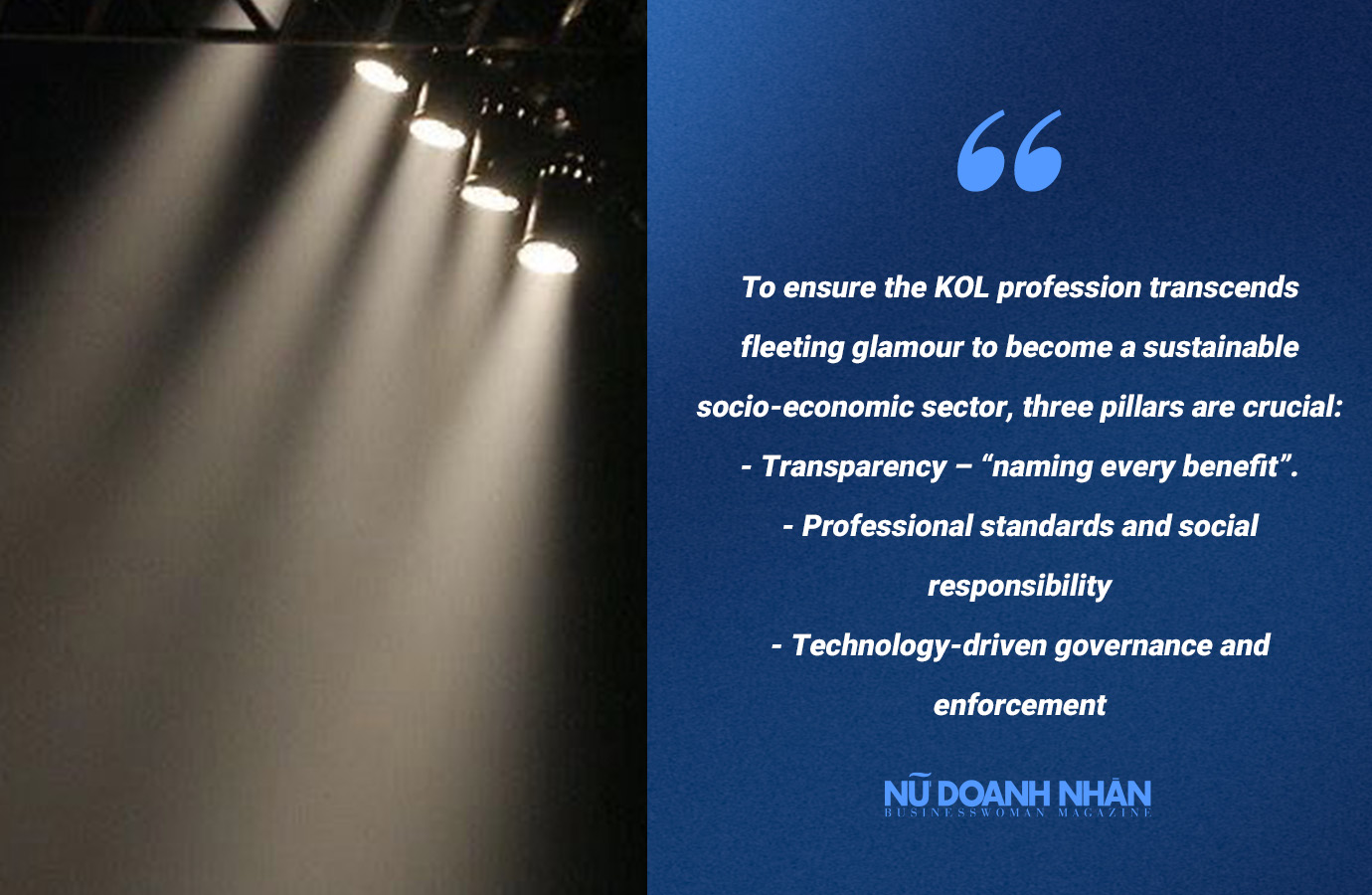
Nevertheless, significant challenges remain. In recent months, the Vietnamese market has recently witnessed a series of controversies involving KOLs. Nguyễn Thúc Thùy Tiên – Miss Grand International 2021 – was fined for promoting Kera vegetable gummies with misleading claims, raising questions about the responsibility of public figures for the products they endorse. A male fitness KOL was “called out” for livestreaming unlicensed supplements promising “rapid fat loss”, posing health risks to consumers. A well-known beauty blogger in Hà Nội lost all contracts after promoting unapproved whitening cosmetics that caused severe allergic reactions. In fashion, a high-profile influencer was accused of endorsing counterfeit products, forcing a public apology and compensation. At the end of 2024, a Vietnamese female streamer was discovered using deepfake technology to impersonate a nutritionist in promotional clips, sparking widespread boycotts and an official platform warning.
Internationally, the lessons are even more striking. China was rocked when “livestream queen” Vi Á (Viya) was fined over 200 million RMB for tax evasion, effectively ending her career overnight. South Korea was shaken by multiple “hidden sponsorship” scandals involving online celebrities, prompting the government to introduce mandatory labelling. In the US, the Fyre Festival, an event hyped by numerous supermodels and high-profile KOLs – became a PR disaster, leading to multi-million-dollar lawsuits and criminal convictions. These cases highlight the fragility of public trust and underscore that today’s KOLs face more than brand backlash or social media outrage – they risk their reputation, career, and even legal consequences if they neglect responsibility.
| To ensure the KOL profession transcends fleeting glamour to become a sustainable socio-economic sector, three pillars are crucial: 1. Transparency – “naming every benefit”. Disclosure is not optional; it is a condition for survival. All benefits – money, gifts, discount codes – must be openly and clearly declared. There should also be mechanisms for recording collaborations and shared accountability between KOLs, brands, and platforms. 2. Professional standards and social responsibility KOLs are not merely communicators; they are custodians of a promise to the public. There must be training in professional ethics, legal literacy, and mandatory certification for sensitive fields such as healthcare, finance, and education. 3. Technology-driven governance and enforcement Platforms must integrate tools to detect fraud, label AI-generated content, and archive collaboration data. Graduated sanctions – warnings, reduced visibility, fines, suspensions – should be applied across all parties. When every link in the chain is held accountable, the ecosystem can function effectively. |
The future: from short-term fame to lasting strength
An industry only truly matures when its reputation rests not on gimmicks but on integrity and responsibility.
In fact, Vietnam has produced KOLs recognised not only for their commercial influence but for their genuine contributions to society. Miss H’Hen Niê is a prime example: from a humble Ê-đê background to the Miss Universe Vietnam crown, she has consistently engaged in philanthropy, raising funds to build libraries and support education in remote areas, inspiring resilience and humility.
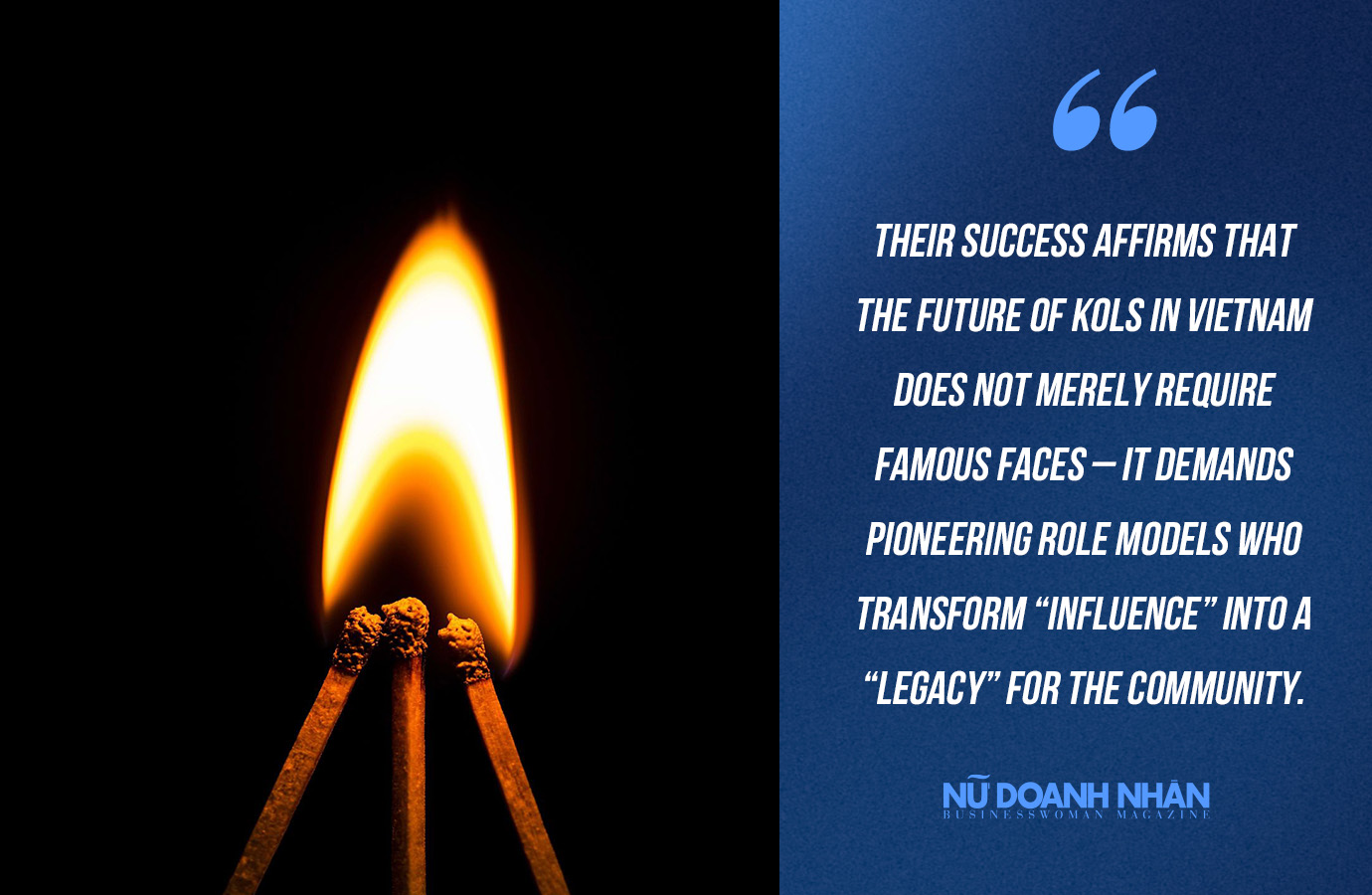
Helly Tống has advanced the green living movement through tangible initiatives like “The Yên Concept” and “Lại Đây Refill Station”, reducing plastic waste and encouraging sustainable consumption habits. Singer Đen Vâu has not only marked the music scene with meaningful lyrics but has also quietly supported disadvantaged students, organising community activities in his hometown of Quảng Ninh. Actress and producer Ngô Thanh Vân has spent years campaigning to protect children from abuse while producing films that portray strong Vietnamese women to international audiences.
These figures demonstrate that when KOLs choose to use their influence to create real value, they not only secure their own standing but elevate the standards of the entire industry. Their success affirms that the future of KOLs in Vietnam does not merely require famous faces – it demands pioneering role models who transform “influence” into a “legacy” for the community.
Text: MINH NGUYỄN

Read more:


